Archive:Quality of life indicators - education
This article has been archived.
Highlights
Across the EU, 87.9 % of three-year-olds were in early childhood education in 2019.
56 % of the EU’s population aged 16-74 had at least a basic level of digital literacy in 2019.
Proportion of the population aged 25-64 years with a high level of educational attainment, 2010 and 2020
This article is part of a Eurostat online publication that focuses on Quality of life indicators, providing recent statistics for the European Union (EU). The publication presents a detailed view of various dimensions that can form the basis for a more profound analysis of the quality of life, complementing gross domestic product (GDP) which has traditionally been used to provide a general overview of economic and social developments.
The focus of this article is the fourth dimension — education — of the nine quality of life indicators dimensions that form part of a framework, endorsed by an expert group on quality of life indicators. Broadly speaking, education refers to any act or experience that has a formative effect on an individual’s mind, character, or physical ability. Education is the process by which society — through schools, colleges, universities and other institutions — deliberately transmits its cultural heritage and its accumulated knowledge, values and skills to each generation.
Full article
Education in the context of quality of life
In knowledge-based economies, education underpins economic growth, as it is the main driver of technological innovation and high productivity. Moreover, as a means to transmit knowledge through generations, education is the basis of human civilisation and has a major impact on the quality of life of individuals. A lack of skills and competencies limits access to the labour market and economic prosperity, increases the risk of social exclusion and poverty, and may hinder a full participation in civic and political affairs. Education enhances people’s understanding of the world they live in, and hence the perception of their ability to influence it.
From a statistical perspective, education is a complex and challenging subject, sometimes difficult to measure. Eurostat's publication Statistical approaches to the measurement of skills — 2016 edition quotes a definition of human capital from the Organisation for Economic Cooperation and Development as 'the knowledge, skills, competencies and other attributes embodied in individuals that are employed in the creation of individual, social and economic well-being'. It goes on to describe skills as 'the ability to apply knowledge and use know-how to complete tasks and solve problems'.
The most common approach used for measuring skills is the indirect approach, where qualifications are used to measure skills supply. These data only certify skills developed in specific education programmes and do not cover skills developed through other means, such as on-the-job training or participation in social activities. One of the difficulties in statistically assessing educational outcomes is the complexity of measuring soft skills, acquired by individuals through social interaction, as well as the knowledge attained outside of the formal educational system (for example, through reading as a leisure pursuit or cultural activities). Moreover, the quality of formal qualifications (such as tertiary education degrees) is not always of the same level, especially when making comparisons across time or between and within countries. Furthermore, data on educational attainment relate to achievements at a specific point in time, which become less representative of current skill levels as time passes. It is therefore important to complement information on formal education attainment and training with information on participation in non-formal educational activities and participation in lifelong learning. As such the overall level of education may be measured through data on formal education attainment and training, as well as statistics related to non-formal or informal educational activities (an increasingly important aspect of the educational process).
As a complement, a direct approach to measuring skills can be followed, either through assessment or self-reporting of abilities. Examples are assessments from the Programme for the International Assessment of Adult Competencies (PIAAC) and self-reported data concerning the command of foreign languages and the use of information technology.
About one third of those aged 25-64 had a tertiary degree in 2020
In 2020, close to one third (32.8 %) of the EU population aged 25-64 years had a tertiary level of educational attainment, while almost half (46.2 %) had completed upper secondary or post-secondary non-tertiary education (see Figure 1). The proportion of people aged 25-64 with a tertiary level of educational attainment increased in all EU Member States between 2010 and 2020.
Higher levels of educational attainment are generally linked to better occupational prospects and higher income, hence having a positive effect on a person’s quality of life. People who have completed tertiary education improve their possibilities to secure a job: in the EU the unemployment rate was higher for low levels of educational attainment and lower for high levels of educational attainment. Based on data on unemployment rates by educational attainment level, in the EU people aged 15-74 years with a low level of education in 2020 were more than three times as likely to be unemployed (13.6 %) as those with a high level of education (4.7 %); the ratio between the unemployment rates for people with high and low levels of education was particularly high in Slovakia, Czechia, Hungary, Bulgaria and Lithuania, while it was relatively low in Cyprus, Portugal and Greece.
When interpreting education levels for the whole of the population, it should be borne in mind that this includes older generations who may have been raised in times when formal education systems were quite different, for example with shorter compulsory education periods. Equally, levels of educational attainment within national populations reflect not only the outcomes of local education systems but also the educational attainment of immigrants.
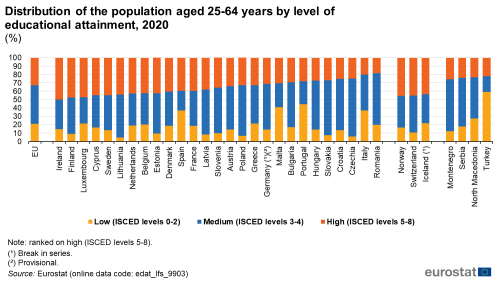
(%)
Source: Eurostat (edat_lfs_9903)
The various education levels leading up to lower secondary education (mainly pre-primary, primary and lower secondary education) form the main part of compulsory schooling in most EU Member States. In four southern Member States, in 2020 more than a quarter of the population aged 25-64 years had completed at most lower secondary education: 44.6 % in Portugal, 40.7 % in Malta, 37.1 % in Spain and Italy. While southern Member States tended to occupy one end of the ranking, the Member States with the lowest shares of people with at most lower secondary education were, with the exception of Finland, all in eastern parts of the EU or the Baltic Member States: in Lithuania, Czechia, Poland, Slovakia, Latvia, Finland, Estonia and Slovenia less than 1 in 10 of the population aged 25-64 were in this category.
The reverse situation can be observed for the share of the population with a medium level of education, with the highest shares generally in eastern EU Member States — Czechia, Slovakia, Romania, Croatia and Poland all reporting shares of at least 60.0 % — and the lowest in southern Member States, below one quarter in Spain and slightly above that in Portugal.
The EU Member States with the highest proportions of people aged 25-64 with a tertiary level of educational attainment in 2020 were mainly in western or northern Europe, although a high share was also observed in Cyprus: at least two fifths of the population had completed tertiary studies in Ireland, Finland, Luxembourg, Cyprus, Sweden, Lithuania, Belgium, Estonia, the Netherlands and Denmark and this was also the case in the three EFTA countries shown in Figure 1. The lowest proportions — below one third — were in eastern and southern Member States, as well as in Germany; the lowest proportions of all were in Romania where less than one fifth of the population had completed tertiary studies.
Figure 2 focuses on the proportion of people aged 25-64 with a tertiary level of educational attainment, showing how this changed between 2010 and 2020. In the EU, this share increased by 8.2 percentage points, from less than a quarter (24.6 %) to close to one third (32.8 %). The smallest and largest increases were in two EU Member States that had relatively low shares in 2020: in Germany the share increased by 4.6 percentage points from 26.7 % in 2010 to 31.3 % in 2020, while in Malta it increased by 15.7 percentage points from 14.9 % in 2010 to 30.6 %.
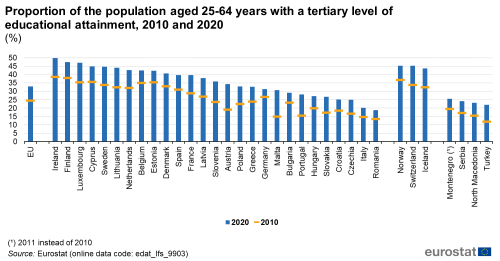
(%)
Source: Eurostat (edat_lfs_9903)
Average adult literacy scores lower in southern Member States
Among the 18 EU Member States for which data are available, average adult literacy scores were lower in the southern Member States than elsewhere in the EU, while they were highest in Finland, the Netherlands and Sweden. There was no clear pattern among the Member States concerning gender differences in adult literacy, however in the candidate country Turkey there was a notably higher level of literacy among men than women.
In this context, literacy is defined as the ability to understand, evaluate, use and engage with written text to participate in society, achieve one’s goals, and develop one’s knowledge and potential. Note that literacy refers exclusively to reading; it does not involve understanding spoken language, nor speaking or writing. Given the growing importance of digital devices and applications as a means of generating, accessing and storing text, the reading of digital texts is increasingly viewed as an integral part of literacy.
The results of the Programme for the International Assessment of Adult Competencies are represented on a 500-point scale, with proficiency levels for individuals defined by particular ranges: 0-175 points is below level 1; 176-225 points is level 1; 226-275 points is level 2; 276-325 points is level 3; 326 or more points are levels 4 and 5. Figure 3 shows the results of surveys conducted mainly in 2011 or 2012 for the population aged 16-65 years, but also in 2017 for Hungary for example. The three southern EU Member States for which data are available [1] — Italy, Spain and Greece — are grouped at the lower end of this ranking, with average literacy scores between 250 and 254 points. Two of the three Nordic Member States are near the top of the ranking, with Finland recording an average of 288 points, the highest among the Member States, and Sweden an average of 279 points, the third highest; Denmark’s average of 271 was towards the top of the middle third of the ranking. Otherwise, there was no clear regional pattern. For example, among the western Member States, the Netherlands recorded the second highest average (284 points) of all Member States, while France (262 points) recorded one of the lowest averages. Equally, among the eastern Member States, Czechia and Slovakia recorded quite high averages (both 274 points), placing them in the top third of the ranking of Member States, while Slovenia recorded the lowest average (256 points) aside from the southern Member States. Hungary was in the middle between the two, with an average of 264.
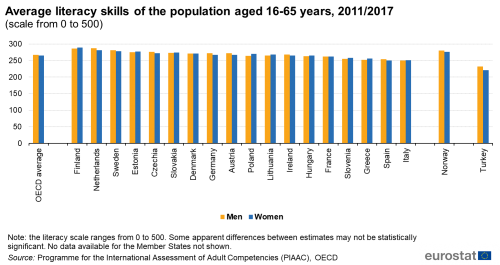
(Scale from 0 to 500)
Source: Eurostat (educ_uoe_enrp07)
Turning towards the two non-member countries shown in Figure 3, Norway recorded a high average (278), in line with neighbouring Sweden, while Turkey recorded an average literacy (227) far below that in any of the EU Member States.
There was no clear pattern to gender differences in adult literacy among the EU Member States. In Denmark, France, Italy and Slovakia the average scores were the same for men and women, while in six Member States the average was higher for women and in eight it was higher for men. In Poland and Greece the average scores were 5-6 points higher for women, while in Spain, Germany and the Netherlands the average scores were 5-6 points higher for men. In Turkey there was a larger gender difference, with the average score for men 11 points higher than for women; note that in Turkey, according to the UNESCO Institute for Statistics, in 2015 the average time that people aged 25 years and over had spent in school was 9.0 years for men and 7.2 years for women.
Over 85 % of 3-year-olds in early childhood education
Early childhood is the stage where education can most effectively influence the development of children and help reverse disadvantage. Early childhood education is typically designed with a holistic approach to support children’s early cognitive, physical, social and emotional development and introduce young children to organised instruction outside of the family context. Importantly, it comprises an intentional education component (and not just care). Early childhood education is made up of two parts: early childhood educational development, designed for children up to two years of age and pre-primary education, designed for children from the age of three years to the start of primary education.
A number of factors concerning pre-primary education have been linked to higher performance later during education, including the length of attendance of pre-primary education, smaller pupil-to-teacher ratios in pre-primary education, and higher public expenditure per child at the pre‑primary level. As such, enrolling pupils in good quality early childhood education may mitigate social inequalities and promote better overall student outcomes.
Across the EU as a whole, 87.9 % of three year-olds were in early childhood education in 2019 (see Figure 4). In sixteen EU Member States at least four fifths of three year-olds were in early childhood education, with this share falling below 70 % in Luxembourg, Slovakia and Greece, where the lowest share of 34.9 % was reached.

(%)
Source: Eurostat (edat_lfse_14)
The highest ratios of enrolments of three year-olds in early childhood education were observed in France (100 %) and Ireland (98.8 %). Most western and northern EU Member States reported high ratios, the exceptions being Austria, the Netherlands and Luxembourg. Eastern Member States generally reported relatively low ratios, although Hungary and Slovenia and the three Baltic States had ratios over 80 %. For the southern Member States there was no clear pattern as this ratio was high in Spain and Italy (over 90 %), somewhat lower in Malta (88.9 %) and Portugal (83.7 %), but considerably lower in Cyprus and particularly in Greece.
Among the EFTA countries, the shares of three year-olds in early childhood education in Iceland and Norway were very high in 2019, in line with the percentages recorded for most northern EU Member States, but the rate was very low (2.4 %) in Switzerland. Among the four candidate countries for which data are available, the patterns also varied but were generally at a lower level than in EU countries: the highest rate being 63.3 % in Montenegro and the lowest at 10.7 % in Turkey.
Early leavers from education and training
Reducing the rate of early leavers from education and training remains a challenge for several EU Member States, notably in Romania, Italy and Spain each of which recorded an early leavers’ rate in 2020 that was still well above the Europe 2020 average target of 10%.
Figure 1 presented information on the distribution of the population according to their level of educational attainment. The main influence on this is the age at which young people leave formal education, whether at the end of compulsory education, after low secondary school (which normally but not always finishes at a later age than compulsory education), or after undertaking upper secondary education. The EU set in 2010 a target to reduce the rate of early leavers from education and training below 10.0 % by 2020. The term early leavers generally refers to persons aged 18 to 24 years who had finished no more than a lower secondary education and were not involved in further education or training; their number can be expressed as a percentage of the total population aged 18 to 24 years. In setting the 2020 headline target, the EU identified early leaving from education and training as an obstacle to economic growth and employment, since on one hand it hampers productivity and competitiveness and on the other fuels poverty and social exclusion. As well as the overall headline target of 10.0 % for the EU as a whole, all of the EU Member States set a national target, taking account of their particular circumstances. Although the strategy has been replaced with the one based on the European Pillar of Social Rights, this indicator is still considered an important one for monitoring policies, and it is included amongst headline indicators for the later strategy as well.
The EU average rate of early leavers from education and training was 9.9 % in 2020, 3.9 percentage points lower than in 2010. Twenty EU Member States managed to reduce their rate of early leavers between 2010 and 2020, some of them significantly. The largest reductions were seen in Portugal (minus 19.4 p.p.) and Spain (minus 12.2 p.p.), the only countries with a double-digit drop.
By contrast, in six countries the rate of early leavers from education and training was higher in 2020 than in 2010, notably in Slovakia (plus 2.9 pp), Czechia (plus 2.7 pp), Hungary (plus 1.3 pp), Sweden (plus 1.2 pp), Luxembourg (plus 1.1 pp) and Bulgaria (plus 0.2 pp). In Poland on the other hand, the rate remined unchanged.
Figure 5 provides an overview of the proportion of early leavers from education and training recorded in 2020 and 2010.
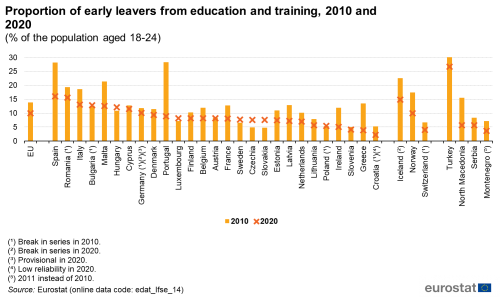
(% of the population aged 18-24 years)
(%)
Source: Eurostat (trng_lfs_02)
NEETs: young people neither in employment nor in education and training
NEETs exceeded 15.0 % in several Member States in southern and eastern parts of the EU
Some young people (aged 18-24 years) in the EU are neither in employment nor in education or training, a situation referred to as NEET. The failure to acquire knowledge and occupational skills and periods of absence from the labour market have been shown to undermine the future prospects of young people. The NEETs indicator shows the share of young persons aged 18 to 24 years who were not employed and were not involved in further education or training. In 2020, 14.4 % of people aged between 18 and 24 years in the EU were in this category. This situation was particularly common (over 15.0 %) in nine EU Member States situated in southern and eastern parts of the EU: Italy, Cyprus, Greece, Bulgaria, Romania, Spain, Croatia, Hungary and France (see Map 1). The highest share was in Italy, where more than one in five young people were neither in employment nor in education and training (24.8 %). However, not all southern and eastern Member States reported high NEET shares, as Malta (9.6 %) and Czechia (8.9 %) were among the nine Member States where less than 1 in 10 young people were NEETs.

(%)
Source: Eurostat (edat_lfse_18)
High shares of NEETs were also observed in the four candidate countries shown in Map 1, while in the three EFTA countries for which data are available the share of young people neither in employment nor in education or training was consistently less than 8.0 %, with the shares in Norway at 6.7 % and those in Iceland even lower at 6.6 %, which was similar to the rate of 5.9 % in the Netherlands, the lowest among all of the EU Member States.
More than 1 in 10 of those aged 25-64 attended training in last four weeks
For many people, education continues beyond the end of the time spent in initial formal education (at school or higher education). Employability largely depends on the skills that people acquire throughout their professional and private lives. In this sense, lifelong learning has become a necessity in a competitive job market, as the needs of enterprises continuously develop, together with the new technologies and techniques adopted by them.
The term lifelong learning encompasses all learning activities undertaken throughout life for personal or professional reasons, also after the end of the initial formal education. Through participation in learning activities people can improve their knowledge, skills and competences and so potentially enhance their careers as well as their quality of life. It is worth clarifying that lifelong learning statistics cover formal and non-formal guided education and training, but exclude self-learning activities. For example, evening courses are included as lifelong learning, whereas reading a history book, or visiting a science museum, although conceptually belonging to the concept of lifelong learning, are not included. The target population of Eurostat’s lifelong learning statistics is all members of private households aged between 25 and 64 years. These data are collected annually through the EU labour force survey (LFS). The indicator on participation shown in Figure 6 identifies the proportion of the target population reporting that they received education or training in the four weeks preceding the survey.
In 2020, the participation in lifelong learning activities was 9.2 % in the EU among the population aged 25-64 years. Lifelong learning was considerably more common among people with a high level of educational attainment than it was among people with a low level of attainment.
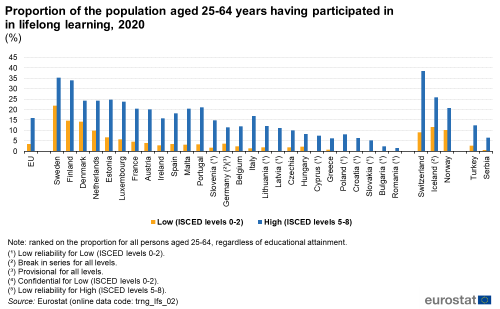
(%)
Source: Eurostat (edat_aes_l21)
Data from 2020 show that Sweden, Finland and Denmark had notably higher rates of participation in lifelong learning programmes than other EU Member States. More than one in five people in these Member States participated in such learning activities whereas in all other Member States the share was below one fifth. Among the EFTA countries, Switzerland (27.6 %) reported a share of its adult population participating in lifelong learning that was higher than in any of the EU Member States except Sweden, while Iceland and Norway also reported relatively high rates. By contrast, participation in lifelong learning was 2.0 % and below in Bulgaria and Romania — lower than in the four candidate countries. The lowest participation rate among the EU Member States was 1.0 % in Romania.
People who have attained a tertiary level of education are more likely to continue studying than those who have completed at most lower secondary education: this was the case in all EU Member States as well as all non-member countries shown in Figure 5. In the EU in 2020, 15.9 % of the population aged 25 to 64 years having a high level of education participated in lifelong learning programmes, compared with 3.4 % of people having a low level of education, a difference of 12.5 percentage points. Particularly large differences were observed in Finland (19.3 percentage points), Estonia and Luxembourg (both 18.1 percentage points). Unsurprisingly, much smaller gaps were observed in some of the Member States with the lowest overall levels of participation in lifelong learning, such as Greece (5.4 percentage points). The enormously different participation rates for lifelong learning between the Member States can be illustrated by comparing the situation in Sweden with many other Member States. In 2020, 21.9 % of people with a low level of education in Sweden reported that they had recently participated in lifelong learning; this was higher than the participation rate for people with a high level of education in 21 of the other EU Member States.
Over 50 % of persons aged 16-74 had basic or above basic digital skills
The ability to use a computer and the command of a foreign language are among the most important competencies in modern economies, not only for the job market but also to take advantage of education, information and cultural opportunities in our increasingly digital and globalised societies.
Concerning digital skills, four skill levels are used for statistical indicators, ranging from 'no skills', through 'low' and' basic' skills to 'above basic' skills. These levels are determined based on activities concerning four domains: information, communication, problem-solving and software skills. For each of these, several activities are identified and, depending on the number of these that a respondent declares having done (combined in some cases with their complexity) a respondent is assigned to one of the four skill levels; to be considered as having basic overall skills, respondents need to have at least basic skill levels in each of these four domains while to be considered as having above basic overall skills, respondents need to have above basic skill levels for all domains.
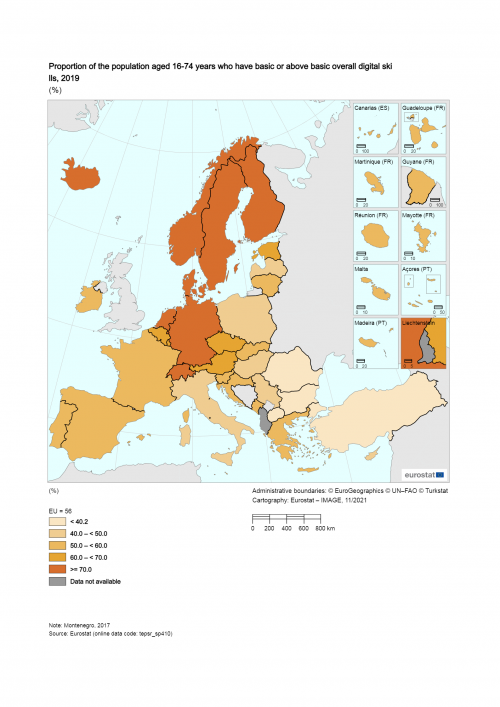
(%)
Source: Eurostat (tepsr_sp410)
A majority of the EU population aged 16-74 years (56 %) had at least a basic level of digital literacy in 2019 (see Map 2). There is however a digital divide, between northern and north-western EU Member States on one hand and some other parts of the EU on the other. Two EU Member States, Bulgaria and Romania, reported that less than one third (29 % and 31 % of their populations respectively) had at least basic digital skills, considerably lower than in any other EU Member State and also lower than in the candidate countries shown in Map 2, where the share ranged from 32 % to 46 %, except in Montenegro where it reached 50 %. The share of the population with at least basic digital skills ranged from 42 % to less than 50 % in Italy, Latvia, Poland, Cyprus and Hungary. Elsewhere in the EU, a majority of the population aged 16-74 years had at least basic digital skills, with the highest shares of 70 % and above in the three Nordic Member States (Denmark, Finland and Sweden) as well as two western Member States, Germany and the Netherlands (which was the only Member State to report a share over three quarters (79 %). Equally, the three EFTA countries for which data are available reported high overall levels of at least basic digital skills (all above 70 %), most notably in Iceland where a higher share than in any EU Member State was reached (85 %) .
Less than one third of persons aged 25-64 do not know any foreign language
Within the 27 EU Member States there are currently 24 official languages, while the EU is home to over 60 indigenous, regional or minority languages, for example Basque and Saami. In most EU Member States an ability to communicate in foreign languages has become increasingly important, not only as a means of communication, but also to facilitate mobility, whether for leisure, study, work or other reasons. One of the EU’s multilingualism goals is for all people to speak two languages in addition to their mother tongue.
The analysis presented in Figure 7 is based on the proportion of the population aged 25-64 years that did not know any foreign language. In 2016, this was the case for less than one third (31.8 %) of the EU population, with a relatively small gender gap as a slightly higher share of men (32.4 %) than women (31.3 %) did not know any foreign language. In three EU Member States — Romania, Hungary and Bulgaria — a majority of the population do not know a foreign language, while this was also the case for 45.8 % of the population in Spain. Elsewhere in the EU, the share of the population not knowing any foreign language was under two fifths, and was below one tenth in Malta and Luxembourg as well as the Baltic and Nordic Member States.
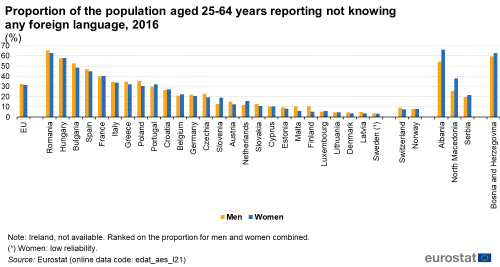
(%)
Source: Eurostat (edat_aes_l21)
In the two EFTA countries shown in Figure 7 less than one tenth did not know a foreign language, while among the candidate countries the shares ranged from one fifth in Serbia to around three fifths in Albania.
In most EU Member States, the gender gap concerning the proportion of the population that did not know any foreign language resulted from a higher proportion among men than among women. In Finland, the proportion of women not knowing a foreign language was 5.3 percentage points lower than that for men, while in Poland, Malta and Bulgaria this gap was between 4.0 and 5.0 percentage points. The reverse situation was observed in Slovenia, the Benelux countries, Portugal, Croatia, Hungary and France, as a higher proportion of women than men did not know a foreign language: this gap was largest in Slovenia (6.1 percentage points) and the Netherlands (4.1 percentage points).
In all three candidate countries for which data are available, the proportion of men not knowing a foreign language was lower than the proportion of women, with gender gaps exceeding 10.0 percentage points in Albania and North Macedonia.
Source data for graphs and maps
Data sources
In the context of quality of life, education refers to: acquired competences and skills; the continued participation in lifelong learning activities; aspects related to access to education.
Data on educational attainment of the population, early school leavers and NEETs are provided by the EU-LFS. Data on self-reported foreign language skills are available from the Adult education survey (AES) and those on self-reported digital skills come from a survey on information and communication technology (ICT) usage in households.
Concerning the acquisition or not of new skills, the indicator on participation in early childhood education is available from education and training statistics (UOE data collection).
Context
Education affects the quality of life of individuals in many ways. People with limited skills and competencies tend to have worse job opportunities and worse economic prospects, while early school leavers face higher risks of social exclusion and are less likely to participate in civic life. But beyond pragmatic considerations, education is in itself of value to our societies, since it allows people to better understand the world they live in.
Education has an important place in EU policy as two headline targets of the overarching Europe 2020 strategy are related to education: at least 40 % of 30-34 year-olds should have completed tertiary education, and drop-out rates from education and training should be less than 10% by 2020. The European Pillar of Social Rights also stresses the importance of education as a pathway to equal opportunities, as several headline indicators and one target (the proportion of adults participating in life long learning in the last 12 months) belong to this field. Furthermore, the strategic framework for European cooperation in education and training (ET 2020) set objectives to make lifelong learning and mobility a reality, as well as improving the quality and efficiency of education and training. Another important European strategy promotes multilingualism with a view to strengthening social cohesion and intercultural dialogue within the EU.
Direct access to
- Quality of life indicators (online publication)
- Digital skills (t_isoc_sk)
- ICT users (t_isoc_sku)
- Individuals who have basic or above basic overall digital skills by sex (tepsr_sp410)
- ICT users (t_isoc_sku)
- Participation in education and training (educ_part)
- Pupils and students - enrolments (educ_uoe_enr)
- Early childhood education and primary education (educ_uoe_enrp)
- Adult learning (trng)
- Main indicators on adult participation in learning - LFS data from 1992 onwards (trng_lfs_4w0)
- Participation in education and training (last 4 weeks) - population aged 18+ (trng_lfs_4w1)
- Main indicators on adult participation in learning - LFS data from 1992 onwards (trng_lfs_4w0)
- Pupils and students - enrolments (educ_uoe_enr)
- Education and training outcomes (educ_outc)
- Educational attainment level (edat)
- Population by educational attainment level (edat1)
- Transition from education to work (edatt)
- Young people by educational and labour status (incl. neither in employment nor in education and training - NEET) (edatt0)
- Early leavers from education and training (edatt1)
- Educational attainment level (edat)
- Languages (educ_lang)
- Self-reported language skills (educ_lang_00)
- Number of foreign languages known (edat_aes_l2)
- Self-reported language skills (educ_lang_00)